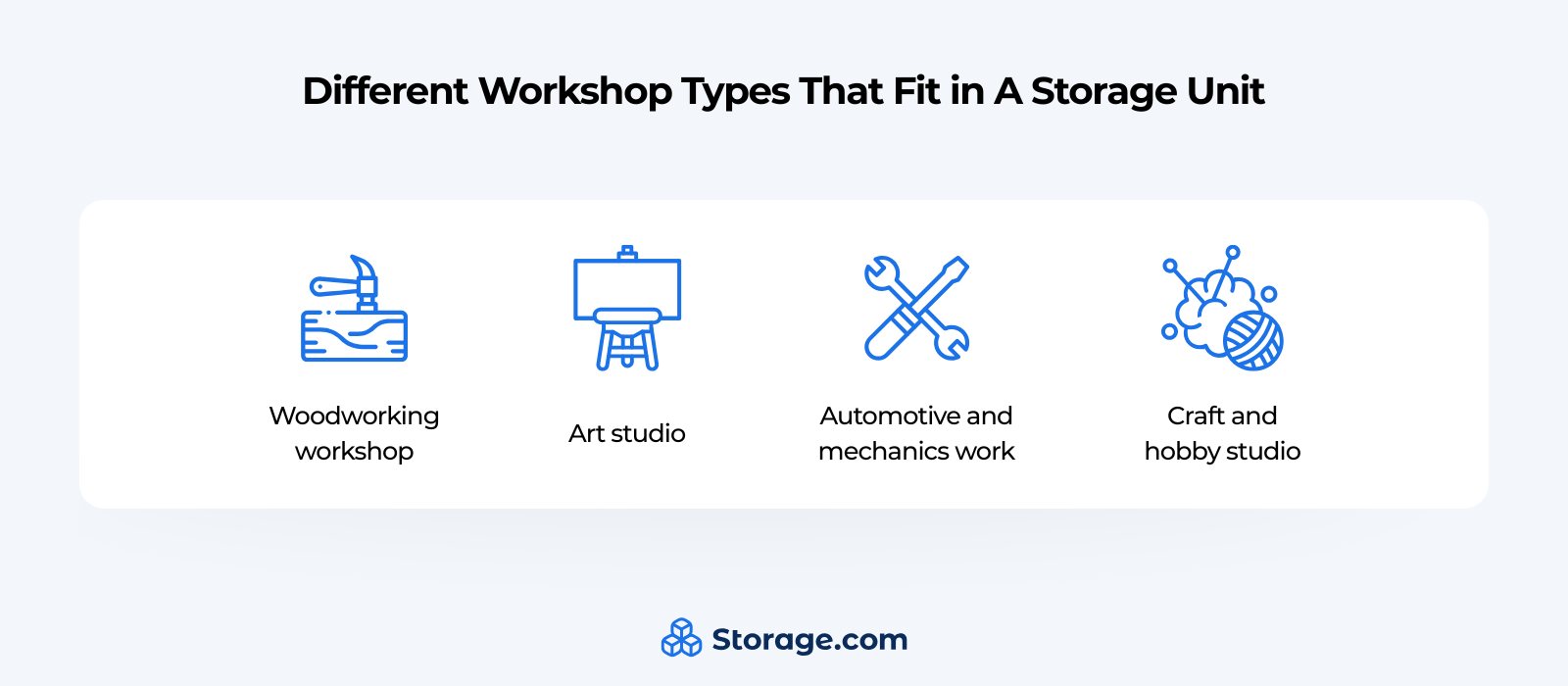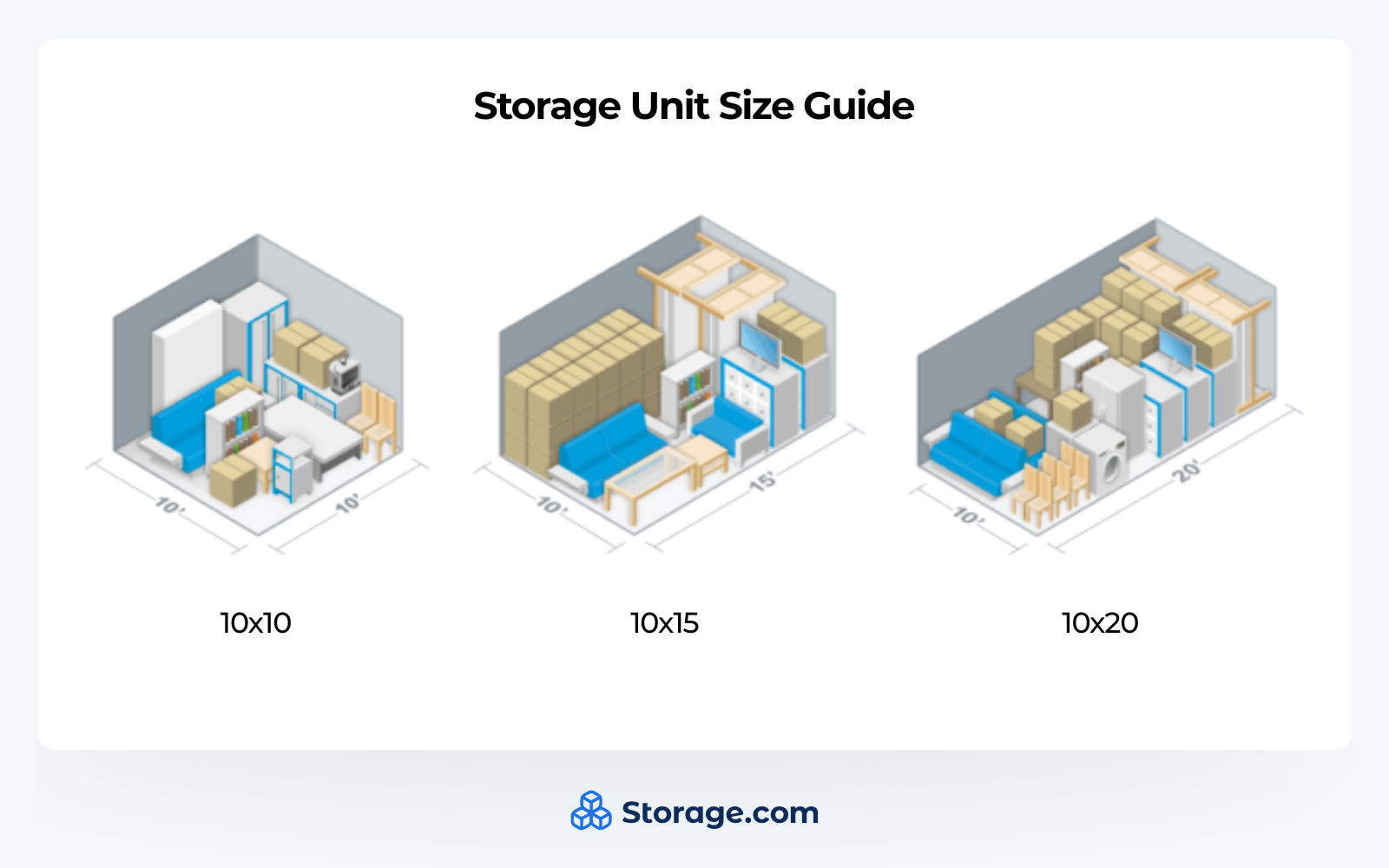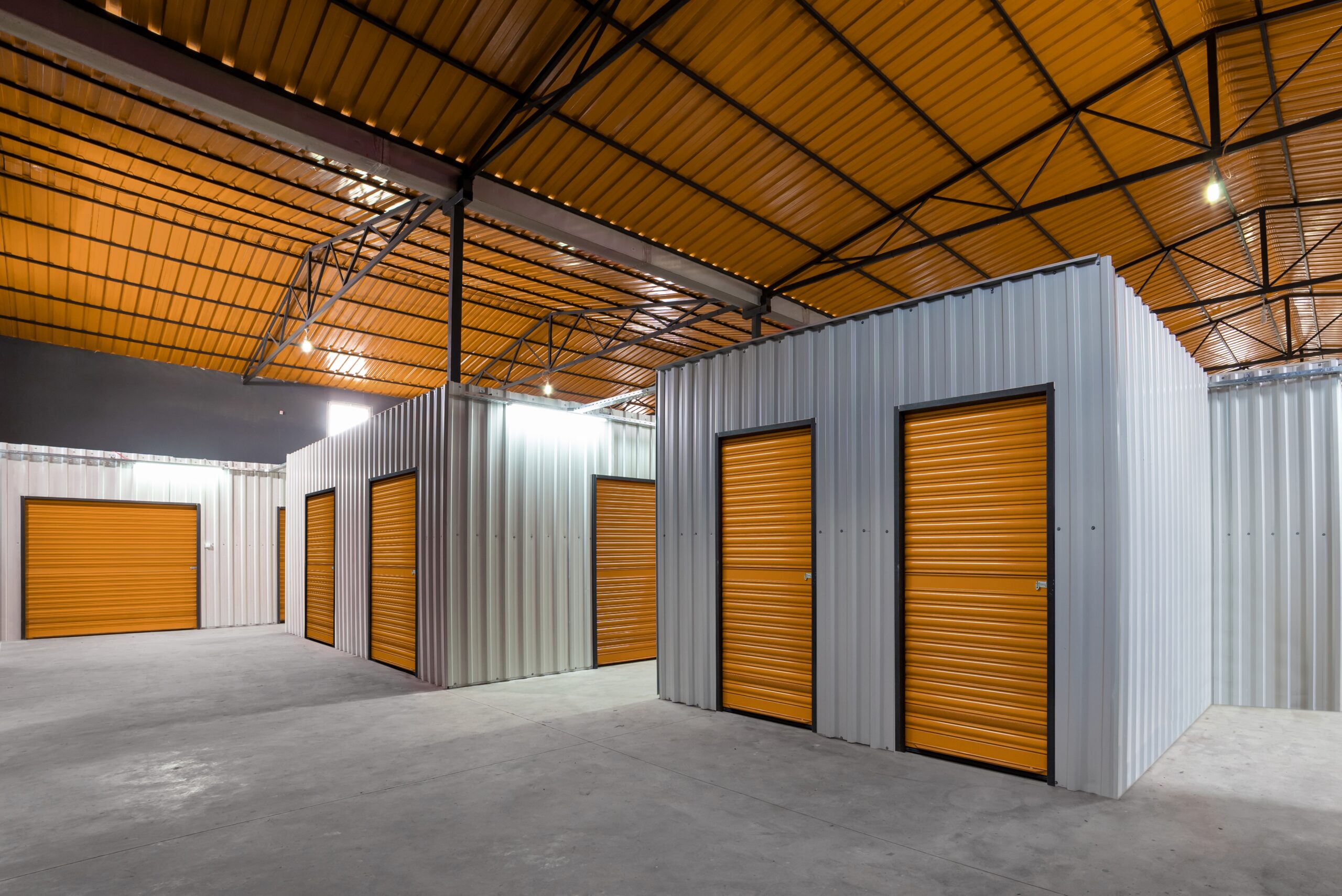Article takeaways
- Using a storage unit as a workshop is a great option if your facility allows active use and your projects stay within safety rules.
- Electricity, ventilation, and climate control make the biggest difference in whether a unit supports woodworking, art, electronics, or other hands-on work.
- Drive-up units are often the most practical option for tools, airflow, and projects that create dust or heat.
- Picking the right size depends on the tools you use and how much room you need to move around your workspace.
- Talking with facilities directly about workshop approval, access hours, and any limits on tools or materials helps you choose a unit that fits the way you work.
Home projects have a way of taking over more space than planned. A dining table becomes a crafting station. A garage slowly fills with tools, bins, and half-finished builds. Even people with dedicated rooms eventually realize they don’t have the quiet, organized, or flexible workspace they need.
That’s when a practical question comes up: Can you use a storage unit as a workshop?
In many cases, yes. Some facilities allow certain types of workshop activity when the work is safe and aligned with their policies. Whether a storage unit will work for you depends on your tools, materials, ventilation needs, and the rules set by the provider. When all of those pieces fit, a storage unit can become a steady, private place to work without the clutter or noise that gets in the way at home.
This guide provides a clear understanding of what to look for when choosing a unit and how to determine whether a storage space can effectively support the type of work you intend to do.
What to Know Before Using a Storage Unit as a Workshop

Before moving in supplies or planning a layout, confirm that the facility allows workshop activity. Some locations accept light crafting, art, woodworking, or electronics repair, while others strictly limit units to storage-only use. A detailed conversation with the manager about your tools and processes helps determine whether your setup meets their expectations.
Electricity is another essential consideration. Using storage units with electricity can make a big difference for projects that rely on lighting, power tools, or charged equipment. Not all units include outlets, and those that do may have use restrictions. Projects involving lighting, power tools, soldering equipment, or charging stations generally need a unit designed for safe electrical access.
Ventilation also plays a role. Work that produces dust, fumes, or heat may feel more comfortable in a drive-up unit with natural airflow. Many workshop users prefer drive-up storage because the direct access and natural airflow make it easier to work with bulky tools and materials. Indoor units can still work well for certain projects, but require more caution with paints, adhesives, and sanding.
Climate control is another major factor, especially for materials that react to temperature or humidity. Comparing climate-controlled vs. non-climate-controlled storage is helpful when you’re working with materials that react to temperature or humidity changes.
Insurance should also be part of your decision. Valuable tools and supplies may require additional coverage. Finally, review access hours. If you tend to work early or late, verify that the facility’s schedule matches your workflow.
Legal and Safety Considerations
Workshop use is only allowed when it meets both facility rules and local safety regulations. While simple crafting, art, light woodworking, and electronics repair may be acceptable, most facilities do not permit activities that create high heat, heavy fumes, or significant fire risks. Spray painting, welding, open flames, hazardous chemicals, and large-scale automotive repairs are typically off-limits.
If you’re using the unit to support a business, certain activities are usually fine. Many renters prepare inventory, build items for online shops, repair electronics, or create artwork. What facilities generally do not allow is turning a storage unit into a storefront, meeting place, office, or workspace that involves regular customer traffic.
If your plans lean more toward music than hands-on work, whether bands can practice in a storage unit includes details about noise expectations and facility rules.
How Different Workshop Types Fit in Storage Units

Certain types of workshops fit naturally into storage units when the facility allows active use. Each option below outlines what the setup typically requires to work well.
Woodworking Workshop
- A 10×20 drive-up unit usually offers the best balance of space and airflow for woodworking layouts. A setup like this often benefits from ideas in the woodworking workshop storage guide, especially when planning tool placement and lumber storage.
- Larger tools, such as table saws and sanding stations, work best along the perimeter so the center stays open for movement.
- Vertical lumber racks help keep materials organized.
- Consider portable dust collection to maintain air quality.
- For additional layout inspiration, DIY sites like Family Handyman and Wood Magazine share sample workshop floor plans.
Art Studio
- Climate control is ideal for paint, inks, canvases, and finished artwork. Keeping materials in good condition also depends on how you’re storing art supplies, especially when temperature or humidity may fluctuate.
- A 10×10 or 10×15 unit can fit easels, rolling carts, drying racks, and shelving.
- LED task lights improve visibility for detail work.
- Simple table-centered layouts help keep the workflow organized.
- Additional inspiration can be found on art studio layout guides through sites like Skillshare or CreativeBloq.
Automotive and Mechanics Work
- Only light automotive activity is typically permitted. Examples include detailing, cleaning parts, and small component replacement. Some light automotive projects also benefit from understanding the cost of car storage, especially when a vehicle is part of your setup.
- A 10×20 unit usually provides enough room to work around a parked vehicle.
- Use protective floor mats and sealed containers for any automotive fluids.
- Always confirm restrictions on tools, jacks, and noise.
Craft and Hobby Studio
- A 5×10 or 10×10 unit can accommodate tables, bins, carts, and sewing or crafting equipment.
- Wall-mounted pegboards and labeled storage help keep materials visible and organized.
- Soft lighting and a comfortable chair create a workspace that feels inviting during long sessions.
- For people who plan to share a creative space with a friend, saving money by sharing a storage unit is helpful for people planning a shared creative or hobby space, and additional layout concepts can be found on crafting sites like The Spruce Crafts or Apartment Therapy.
Electronics or Repair Workshop
- A 5×10 climate-controlled unit protects sensitive components and tools.
- Antistatic mats, surge protectors, and organized project bins keep the space efficient.
- Shelving or drawer systems make it easier to separate parts by project.
- For setup ideas, DIY electronics communities like Adafruit and Instructables offer layout suggestions.
Tips for Setting Up Your Storage Unit Workshop
Different workshops call for different footprints. Smaller electronics or craft setups work comfortably in a 5×10, while art studios and moderate craft spaces fit well in a 10×10 or 10×15. Woodworking, automotive detail work, and projects with larger tools often require a 10×20 or larger. Before choosing a size, review Storage.com’s guide on signs you’re ready for self-storage, which can help determine whether a workshop unit fits your long-term needs. The right size depends on how much room you need to move around your equipment without feeling crowded.
Art studios and moderate craft spaces fit well in a 10×10 or 10×15. Woodworking, automotive detail work, and projects with larger tools are more appropriate for a 10×20 or larger. The right size depends on how much room you need to move around your equipment without feeling crowded.
Typical Pricing Ranges
While prices vary by region, climate control, and facility features, national averages provide a helpful starting point. The table below offers a clearer sense of what different workshop-friendly unit sizes generally cost each month.
| Unit Size | Typical Monthly Price Range | Best For |
|---|---|---|
| 5×10 | $60 to $120 | Small crafts, electronics repair, compact workstations |
| 10×10 | $90 to $160 | Art studios, multi-table crafting setups |
| 10×15 | $120 to $220 | Larger hobby projects, mixed-use spaces with storage and work zones |
| 10×20 | $150 to $280 | Woodworking, light automotive projects, larger tools and materials |
These prices can shift based on availability and demand, as well as features like climate control or extended access hours. Comparing facilities in your area will give you the clearest picture of what to expect.
Comparing Unit Sizes

Different workshops call for different footprints. Smaller electronics or craft setups work comfortably in a 5×10, while art studios and moderate craft spaces fit well in a 10×10 or 10×15. Woodworking, automotive detail work, and projects with larger tools often require a 10×20 or larger. Before choosing a size, you’ll want to write down any signs you’re ready for self-storage, which can help determine whether a workshop unit fits your long-term needs. The right size depends on how much room you need to move around your equipment without feeling crowded.
Choosing the Right Facility
Some facilities are better suited for workshop use than others. Drive-up access is helpful if you handle heavy or bulky materials. Climate control protects sensitive supplies. Security features like gated entry and cameras offer peace of mind if you’re storing valuable tools.
Cleanliness, good lighting, and well-maintained units show that the facility takes upkeep seriously. If you think your space may function more like a quiet office than a hands-on workshop.
For quieter or more administrative setups, setting up an office in a storage unit can offer ideas for arranging a functional work area. Most importantly, clear rules about workshop use help you avoid guesswork or limitations once you start working.
Essential Questions to Ask Storage Facilities
The right workshop setup starts with good information, and asking the facility a few direct questions will help you understand what’s allowed and what kind of unit will genuinely work for your projects.
- Do you allow workshop use in storage units?
- Are electrical outlets available, and what’s the power capacity?
- Is climate control available?
- What are the access hours?
- Are there noise restrictions?
- What insurance requirements exist?
- Are there restrictions on specific activities (welding, spray painting, etc.)?
- What’s the policy on waste disposal?
Asking these ahead of time makes it easier to choose a unit that matches the way you work.
When a Storage Unit Isn’t the Right Fit
Some projects simply need more than a storage unit can safely provide. Tools that produce loud noise, heavy fumes, or high heat often require ventilation systems that cannot be installed in storage. Work involving large machinery, constant power demands, or frequent customer interaction may also be better suited for a dedicated studio or commercial space.
Creating a Comfortable, Functional Workspace
A workshop feels more efficient when everything has a place. Many people start by organizing vertically with shelving, pegboards, and tall cabinets, which keep the floor open for movement.
Portable workstations, such as rolling carts and foldable benches, make it easy to adjust your layout as projects shift from stage to stage. Dividing the space into simple zones for tools, active projects, and storage helps reduce clutter and makes cleanup faster.
Lighting is another major factor in how a unit feels. LED shop lights brighten large areas without adding heat, while clamp-on lamps help with detail work.
A quick weekly cleanup goes a long way toward keeping the space dust-free and preventing hazards. Soft mats or foam tiles can help reduce noise, add comfort underfoot, and make you a considerate neighbor.
Making Your Workshop Work in a Storage Unit
A storage unit can function as an effective workshop when you plan ahead and make sure the space matches the way you work. The most successful setups come from choosing a facility that clearly approves your workshop activity, staying within safety guidelines, and selecting a unit with the features your tools and materials need.
If you’re unsure whether a facility allows the kind of work you want to do, reach out and ask. A quick conversation can confirm electrical options, climate control, access hours, noise expectations, and any limits on tools or materials.
When you’re ready to find a unit that supports your projects, Storage.com makes it simple to compare locations and features in your area. You can look for drive-up access, climate control, or larger unit sizes that work well for workshop setups.
To get started, visit Storage.com and find a storage facility near you that accommodates workshop use, so you can set up a space that’s safe, comfortable, and ready for the work you want to do.






